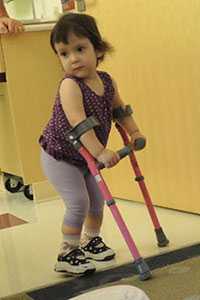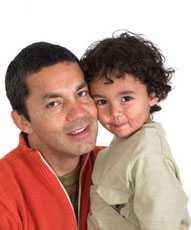Living With Spina Bifida: Toddlers and Preschoolers

Life with a toddler or preschooler is both fun and challenging. These young children experience huge mental, social, and emotional changes. They have a lot of energy and enthusiasm for exploring and learning about their world and becoming independent. Developing independence can be especially challenging for children with spina bifida. Parents should start helping their child develop independence early in childhood.
Encouraging Independence
For toddlers and preschoolers with spina bifida, there are many ways that parents and other caregivers can help them become more active and independent, such as:
- Teaching the child about his or her body and about spina bifida.
- Encouraging the child to make choices, such as between two items of clothing.
- Asking the child to help with daily tasks, such as putting away toys.
Children with spina bifida might need extra help at times. But it is very important that children be given the opportunity to complete a task before help is given. It is also important that parents give only the help that is needed rather than helping with the entire task. Parents must learn the difficult balance between giving the right amount of help to increase their child’s independence and confidence, while at the same time being careful not to give the child tasks that cannot reasonably be completed―which might decrease their child’s confidence.
Physical Health―What to Expect
No two children with spina bifida are exactly alike. Health issues will be different for each child. Some children have issues that are more severe than other children. With the right care, children born with spina bifida will grow up to reach their full potential.
Mobility and Physical Activity
Children affected by spina bifida get around in different ways. These include walking without any aids or assistance; walking with braces, crutches or walkers; and using wheelchairs.
Children with spina bifida higher on the spine (near the head) might have paralyzed legs and use wheelchairs. Those with spina bifida lower on the spine (near the hips) might have more use of their legs and use crutches, braces, or walkers, or they might be able to walk without these devices.
A physical therapist can work with children, parents, and caregivers to teach them how to exercise the child’s legs to increase strength, flexibility, and movement.
Regular physical activity is important for all children, but especially for those with conditions that affect movement, such as spina bifida. There are many ways for children with spina bifida to be active. For example, they can:
- Engage in active play with friends.
- Roll or walk in the neighborhood.
- Enjoy parks and recreation areas with playgrounds that are accessible for those with disabilities.
- Participate in community programs, such as the Early Intervention Program for Infants and Toddlers with Disabilities and Special Education Services for Preschoolers with Disabilities, which are free programs in many communities.
- Do exercises recommended by a physical therapist.
For more information, please visit the following websites:
Early Intervention Programs for Infants and Toddlers
Special Education Services for Preschoolers with Disabilities
National Center on Physical Activity and Disability (NCPAD) – Spina Bifida Guidelines
Using the Bathroom
Children with spina bifida often cannot control when they go to the bathroom (incontinence). They also can develop urinary tract infections. It is important to develop a plan for going to the bathroom that works and is as simple as possible. This can lead to increased health, participation, and independence at school and in the home, and avoid embarrassment for children with spina bifida. Healthcare providers can help develop a plan for the child. A tube (catheter) inserted in the child’s bladder can help drain urine. In some cases, extra fiber can be added to the diet to keep bowel movements regular. Surgery also might be recommended.
For more information, please visit the Spina Bifida Association website:

Skin
Children with spina bifida can develop sores, calluses, blisters, and burns on their feet, ankles, and hips. However, they might not know when these develop because they might not be able to feel certain parts of their body. In addition, toddlers might not know how to tell their parents about issues with their skin.
Parents and caregivers can help protect the child’s skin and teach the child how to do this, too, by:
- Checking the child’s skin every day for redness, including under braces.
- Trying to avoid hot bath water, hot irons and hot or unpadded seatbelt clasps that may cause burns.
- Making sure the child wears properly fitting shoes at all times.
- Using sunscreen on the child and making sure the child doesn’t stay out in the sun too long.
- Making sure the child is not sitting or lying in one position for too long.
Did You Look? Healthy Skin Starts With You! Care for infants & toddlers with spina bifida
Health Checks
Every child needs a primary health care provider (for example, a pediatrician, family doctor, or nurse practitioner). The primary health care provider will want to make sure that the child is healthy; developing normally; and receiving immunizations against diseases and infections, including the flu.
In addition to seeing a primary health care provider, a child with spina bifida will be checked and treated as needed by doctors who specialize in different parts of the body. These doctors might suggest treatments or surgeries to help the child.
These specialists might include:
- An orthopedist, who will work with the child’s muscles and bones.
- A urologist, who will check the child’s kidneys and bladder.
- A neurosurgeon, who will check the child’s brain and spine.
Safety
Safety is an important issue for children with spina bifida. They can be at higher risk for injuries and abuse. It is important for parents and other family members to teach them how to stay safe and what to do if they feel threatened or have been hurt in any way.
For more information, please visit the following websites:
Infants & Toddlers – Safety in the Home & Community
Bullying Among Children and Youth with Special Needs and Disabilities
Positive Parenting Tips
Find tips for positive parenting, health, and safety.
Finding Support
Having support and community resources can help increase confidence in managing spina bifida, enhance quality of life, and assist in meeting the needs of all family members. It might be helpful for parents of children with spina bifida to talk with one another. One parent might have learned how to address some of the same concerns another parent has. Often, other parents of children with special needs can give advice about good resources for these children.
Remember that the choices of one family might not be best for another family, so it’s important that parents understand all options and discuss them with their child’s health care providers.
- A Spina Bifida Association (SBA) Chapter is a great place to connect with other families. The SBA website can provide information on how to find a local chapter.
- The Spina Bifida Association Listservs bring people together online to discuss topics such as parenting a child with spina bifida and growing up with spina bifida.
- National Resource Center Get information and find clinics or health care providers who are experts on spina bifida.
References
Sandler, Adrian, M.D.(2004). Living with Spina Bifida: A Guide for Families and Professionals. University of North Carolina Press: Chapel Hill.
Merkens, Mark J., M.D. and the Spina Bifida Association’s Professional Advisory Council (2006). Guidelines for Spina Bifida Health Care Services Throughout the Lifespan. Third Edition. Spina Bifida Association.
- Page last reviewed: September 18, 2017
- Page last updated: September 18, 2017
- Content source:


 ShareCompartir
ShareCompartir